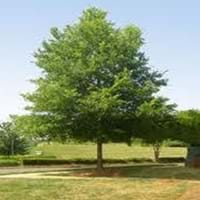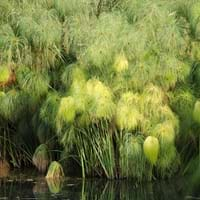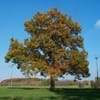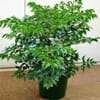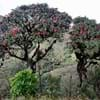Life Span
Perennial
Perennial
Origin
North America, United States, Northeastern United States, Mid-Atlantic United States, Southeastern United States, Central United States, South-Central United States, Texas
Africa
Types
Not Available
C. papyrus, C. papyrus 'Nanus
Number of Varieties
Not Available
Habitat
Hot climate regions, low mountains, Tropical regions
Lakes, Shores of rivers or lakes, sluggish streams and rivers, Swamps
USDA Hardiness Zone
6-9
7-11
Sunset Zone
2a, 2b, 3a, 3b, 4, 6, 7, 8, 9, 10, 11, 12, 13, 14, 15, 16, 18, 19, 20, 21
H1, H2, 16, 17, 23, 24
Habit
Oval or Rounded
Clump-Forming
Flower Color
Red, Light Green, Chartreuse
Tan
Flower Color Modifier
Bicolor
Bicolor
Fruit Color
Tan, Chocolate
Brown
Leaf Color in Spring
Green, Light Green
Green, Light Green
Leaf Color in Summer
Green, Dark Green
Green, Light Green
Leaf Color in Fall
Yellow, Orange, Sandy Brown
Green, Light Green
Leaf Color in Winter
Not Available
Green, Light Green
Leaf Shape
Irregular
Grass like
Plant Season
Spring, Fall
Spring, Summer, Fall, Winter
Sunlight
Full Sun, Partial Sun
Full Sun, Partial Sun
Type of Soil
Clay, Loam, Sand
Clay, Loam, Sand
The pH of Soil
Acidic, Neutral, Alkaline
Neutral
Soil Drainage
Average
Poorly Drained
Bloom Time
Spring, Late Spring
Indeterminate
Tolerances
Wet Site, Pollution, Soil Compaction
Drought
Where to Plant?
Ground
Container, Ground, Pot
How to Plant?
Grafting, Seedlings
Stem Planting
Plant Maintenance
Low
Medium
Watering Requirements
Allow to dry out slightly between watering, Does not require lot of watering
Average Water Needs, Keep ground moist, Requires a lot of watering
In Summer
Lots of watering
Lots of watering
In Spring
Moderate
Moderate
In Winter
Average Water
Average Water
Soil pH
Acidic, Neutral, Alkaline
Neutral
Soil Type
Clay, Loam, Sand
Clay, Loam, Sand
Soil Drainage Capacity
Average
Poorly Drained
Sun Exposure
Full Sun, Partial Sun
Full Sun, Partial Sun
Pruning
cut main flower spike, Prune every year, Remove damaged leaves, Remove dead branches, Remove dead leaves
Remove damaged leaves, Remove dead branches, Remove dead leaves
Fertilizers
All-Purpose Liquid Fertilizer, Bonemeal, fertilize in growing season
All-Purpose Liquid Fertilizer
Pests and Diseases
Azalea leaf gall, Fusarium leaf spot, Leaf rust, Mildew
fungus
Plant Tolerance
Heat Tolerance, Humidity, Salt and Soil Compaction
Drought
Flowers
Insignificant
Showy
Flower Petal Number
Not Available
Single
Foliage Texture
Fine
Not Available
Foliage Sheen
Glossy
Glossy
Attracts
Birds
Flying insects, Hummingbirds
Allergy
Eczema, Rhinitis, Runny nose
Not Available
Aesthetic Uses
Landscape Designing, Showy Purposes
Showy Purposes
Beauty Benefits
Blood purifying, Reduce Bruises, Weightloss
Not Available
Edible Uses
Sometimes
Insignificant
Environmental Uses
Air purification
Air purification
Medicinal Uses
Gout, Obesity, Snoring
Cancer, Heals minor burns, Wounds
Part of Plant Used
Bark, Stem
Stem
Other Uses
Animal Feed, Biodiesel, Recovering internal injuries
Constructing Boats, Used as fuel, Used in paper industry
Used As Indoor Plant
No
Yes
Used As Outdoor Plant
Yes
Yes
Garden Design
Shade Trees, Street Trees
Bog Garden, Container, Feature Plant, Houseplant, Mixed Border, Water Gardens
Botanical Name
QUERCUS phellos
CYPERUS 'Wild Spike'
Common Name
Willow Oak
Papyrus, Wild Spike Cyperus
In Hindi
Overcup ओक
पेपिरस संयंत्र
In German
Overcup Oak
ägyptischen Papyrus-Pflanze
In French
Overcup Oak
Papyrus égyptien
In Spanish
Overcup Roble
Papiro egipcio
In Greek
Overcup Oak
αιγυπτιακό πάπυρο
In Portuguese
Overcup Oak
Papiro egípcio
In Polish
Overcup Dąb
Papiro egipcio
Phylum
Not Available
Magnoliophyta
Class
Magnoliopsida
Agaricomycetes
Family
Fagaceae
Cyperaceae
Clade
Angiosperms, Eudicots, Rosids
Angiosperms, Commelinids, Monocots
Tribe
Not Available
Cariceae
Subfamily
Amaryllidoideae
Cyperoideae
Number of Species
Not Available
Not Available
Season and Care of Willow Oak and Egyptian Papyrus
Season and care of Willow Oak and Egyptian Papyrus is important to know. While considering everything about Willow Oak and Egyptian Papyrus Care, growing season is an essential factor. Willow Oak season is Spring and Fall and Egyptian Papyrus season is Spring and Fall. The type of soil for Willow Oak is Clay, Loam, Sand and for Egyptian Papyrus is Clay, Loam, Sand while the PH of soil for Willow Oak is Acidic, Neutral, Alkaline and for Egyptian Papyrus is Neutral.
Willow Oak and Egyptian Papyrus Physical Information
Willow Oak and Egyptian Papyrus physical information is very important for comparison. Willow Oak height is 1,220.00 cm and width 910.00 cm whereas Egyptian Papyrus height is 60.00 cm and width 60.00 cm. The color specification of Willow Oak and Egyptian Papyrus are as follows:
Willow Oak flower color: Red, Light Green and Chartreuse
Willow Oak leaf color: Green and Light Green
Egyptian Papyrus flower color: Tan
- Egyptian Papyrus leaf color: Green and Light Green
Care of Willow Oak and Egyptian Papyrus
Care of Willow Oak and Egyptian Papyrus include pruning, fertilizers, watering etc. Willow Oak pruning is done cut main flower spike, Prune every year, Remove damaged leaves, Remove dead branches and Remove dead leaves and Egyptian Papyrus pruning is done Remove damaged leaves, Remove dead branches and Remove dead leaves. In summer Willow Oak needs Lots of watering and in winter, it needs Average Water. Whereas, in summer Egyptian Papyrus needs Lots of watering and in winter, it needs Average Water.
